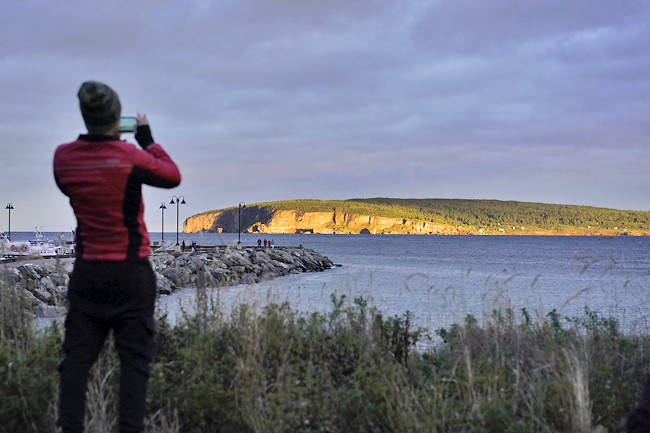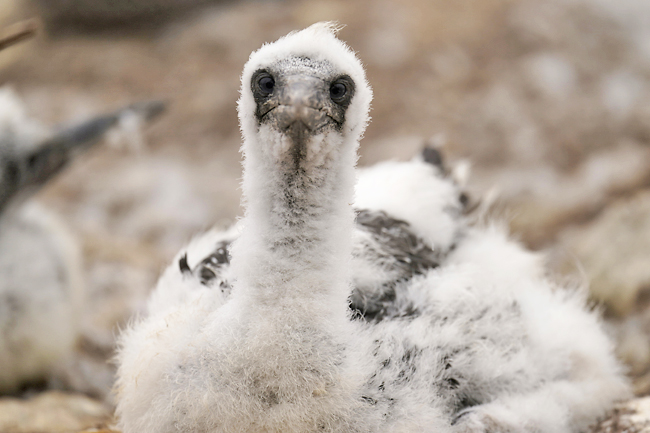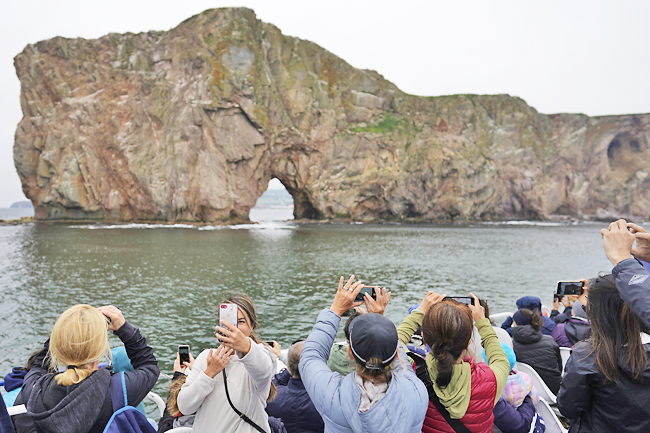Calvin Woodward
PERCE, QUEBEC (AP) – On Quebec’s Bonaventure Island, the ghosts of human habitation from years past and the birds that breed there now in extraordinary numbers tell the same story: of lives lived hard in a place of fairy-tale beauty.
You see this from the tender ages on the family gravestones of islanders who scratched out a living from the late 1700s to when Bonaventure went entirely to the birds a half century ago.
You see it from the tenacious colony of 100,000-plus northern gannets as they plunge into the sea for prey, soar back to their nests and fight at the least provocation, sometimes to the death, for their territory on a plateau high above the waters or in crannies of the cliffs.
Nothing is easy for the gannets. Not in this age of warming seas, competition with trawlers for fish, pollution, supercharged storms and the onset of avian flu.
That’s especially so when those perils are combined with their curious compulsion, shared by many seabirds, to return each spring to the exact spot they left the year before. For these spirited divas, the next nesting spot over just won’t do.
Worldwide, it remains difficult or impossible to tie any one massive die-off of seabirds or breeding calamity solely to global warming, for nature has its own jarring rhythms of abundance and deprivation.




But the evidence writ large, over decades, is unassailable: Warming and rising seas and the erratic weather events fuelled by a changing climate are taking a heavy toll on seabirds.
University of British Columbia researchers say seabird populations have fallen 70 per cent since the mid-20th Century.
Climate-related losses have, for example, hit albatrosses in the central Pacific, common murres and Cassin’s auklets along the United States (US) West Coast, puffins off the Maine coast, penguins in South Africa, endangered roseate terns off New England, and brown pelicans on vanishing islands off southeastern Louisiana.
The struggles of many seabird species occur in marine wilderness far from humans. Those of the Bonaventure gannets, however, play out in plain sight, in a gift to scientists and the public, on the protected grounds of the Quebec government’s Parc national de l’lle-Bonaventure-et-du-Rocher-Perce.
The Bonaventure gannets display a “clumsy and funny little side on land which has nothing to do with what it is when it is at sea,” said leading Quebec researcher of the birds David Pelletier.
At sea the gannets are magnificent in their grace and power.
Using air currents off the water, they fly effortlessly high over the sea and dive nearly straight down in their hunt for fish, piercing the surface at 100 kilometres an hour like so many white missiles. Their black-tipped wings, which span two metres , are tightly tucked behind them.
They dive in huge numbers near the island when mackerel – the prey that gives them the most energy – or herring or other smaller fish are abundant there.
It’s a sight that amazes even the most seasoned scientists every time. “It’s so wow,” said a pre-eminent gannet researcher at the University of Quebec in Rimouski Magella Guillemette, as he described watching the feeding frenzy from his small boat in the thick of it.
With the island less than three kilometres from the Perce harbor, these Bonaventure birds are remarkably accessible to biologists and visitors who hike on trails thick with wildflowers in summer to see the birds up close.
The clamour of the birds greets the hikers even before the full colony comes into view.
The gannets, unlike many other seabirds, seem utterly indifferent to humans. They gaze right through you with their porcelain blue eyes.
“It’s rare that we have the possibility to look at wild animals like this,” said the park’s services manager Marie-Dominique Nadeau-Girard. “And they stay there, they don’t look at you, they live their life, and you’re just looking at them and learning.”
Guillemette’s student researchers are busy each summer studying the birds. Over the years, they have put leg bands and GPS systems on hundreds of them. What’s striking about gannets is that the researchers can simply pick them up, without fear of disturbing their nests.
“You just catch that bird,” Guillemette said. “You weigh them, you put some devices on them and then you put it back to the nest and it’s just staying there.”
THE ECO-SENTINELS
All of this makes the Bonaventure gannets ideal sentinels for the health of the marine ecosystem in the gulf and clattering storytellers to the planet. They form the world’s second largest gannet colony and are easier to reach than the largest, on Scotland’s remote Bass Island.
Québec’s on-the-ground experts on the colony, Canadian government biologists, and seabird scientists globally say there is little to no question that global warming is reshaping the lives of the northern gannets. Warmer sea temperatures drive their prey to cooler depths, distant waters or both.
But the full impact of climate change is not yet established and overfishing may be an even greater danger. In tandem, the threats from fishing and warming are forcing the gannets to go farther from their Bonaventure nests in search of food for their island chicks and themselves. The distance the birds fly on a single fishing trip has more than doubled in recent years to an average of 500 kilometres, leaving one mate and the chick waiting several days or longer to be fed by the hunter, Guillemette said.
If the mate on the nest gets too weak from hunger, it may fly off for food, too, leaving the young one to starve or to wander from the nest and risk being killed by an adult. Like many seabirds, adult gannets are highly territorial and may kill any intruders to their nesting areas; AP journalists witnessed two such deadly attacks on the young on a day shortly before the winter migration.
Researchers have been able to draw a strong correlation between the supply of mackerel in the gulf and the number of chicks produced.
In 2012, when there were almost no mackerel, only four per cent of the nests produced a chick, Guillemette said, a record low attributed to unusually warm waters that year.






